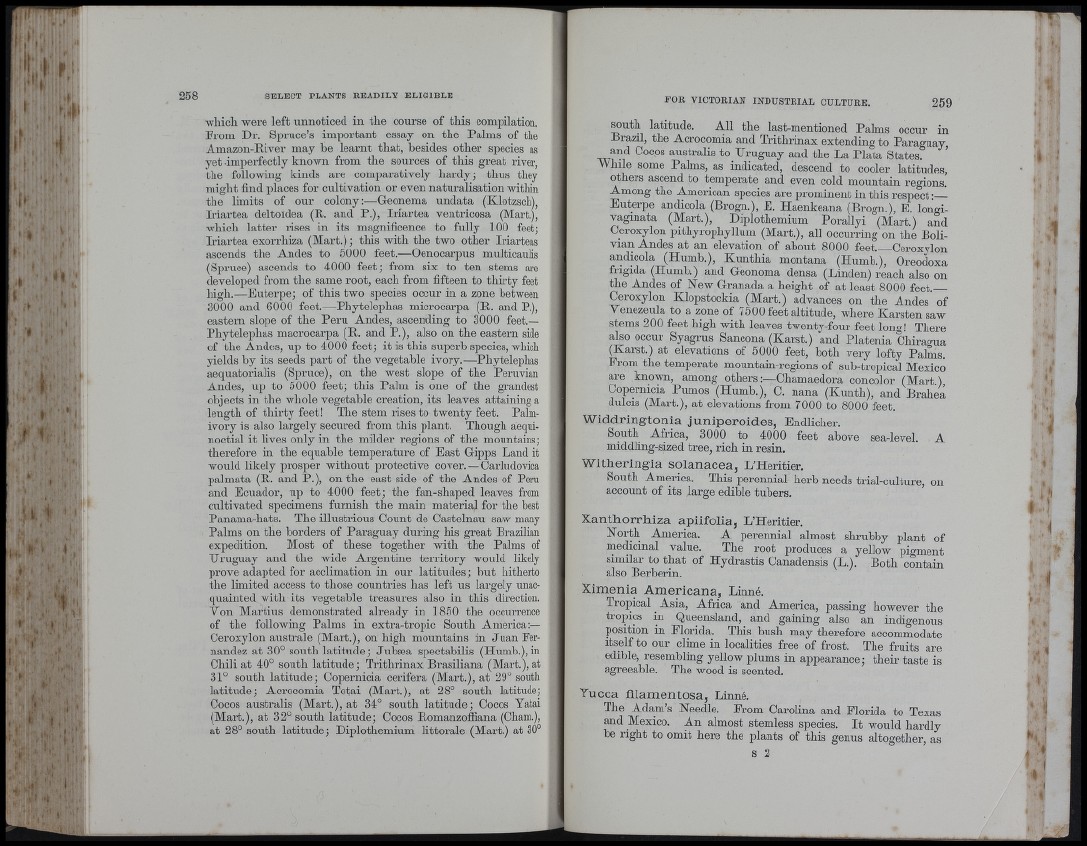
- î ■
I
í i
* I
i!
* l 1
1 ' ,
< « t t,
wliicli were left unnoticed in the course of this compilation.
Erom Dr. Spruce’s important essay on the Palms of the
Amazon-River may be learnt that, besides other species as
yet -imperfectly known from the sources of this great river,
the following kinds are comparatively hardy; thus they
might find places for cultivation or even naturalisation within
the limits of our colony:—Geonema undata (Klotzscli),
Iriartea deltoidea (R. and P.), Iriartea ventricosa (Mart.),
which latter rises in its magnificence to fully 100 feet;
Iriartea exorrhiza (Mart.); this with the two other Iriarteas
ascends the Andes to 5000 feet.—Oenocarpus multicaulis
(Spruce) ascends to 4000 feet; from six to ten stems are
developed from the same root, each from fifteen to thirty feet
high.—Euterpe; of this two species occur in a zone between
3000 and 6000 feet.—Phytelephas microcarpa (R. and P.),
eastern slope of the Peru Andes, ascending to 3000 feet—
Phytelephas macrocarpa (R. and P.), also on the eastern side
of the Andes, up to 4000 feet; it is this superb species, which
yields by its seeds part of the vegetable ivory.—Phytelephas
aequatorialis (Spruce), on the west slope of the Peruvian
Andes, np to 5000 feet; this Palm is one of the grandest
objects in the whole vegetable creation, its leaves attainmg a
length of thirty feet! The stem rises to twenty feet. Palm-
ivory is also largely secured from this plant. Though aequi-
noctial it lives only in the milder regions of the mountains;
therefore in the equable temperature of East Gipps Land it
would likely prosper without protective cover. — Carludovica
palmata (R. and P.), on the east side of the Andes of Peru
and Ecuador, up to 4000 feet; the fan-shaped leaves from
cultivated specimens furnish the main material for the best
Panama-hats. The illustrious Count de Castelnau saw many
Palms on the borders of Paraguay during his great Brazilian
expedition. Most of these together with the Palms of
Uruguay and the wide Argentine territory would likely
prove adapted for acclimation in our latitudes; hut hitherto
the limited access to those countries has left us largely unacquainted
with its vegetable treasures also in this direction.
Yon Martius demonstrated already in 1850 the occurrence
of the following Palms in extra-tropic South America:—
Ceroxylon austraie (Mart.), on high mountains in Juan Fernandez
at 30° south latitude; Jnbsea spectabilis (Humb.), in
Chili at 40° south latitude; Trithrinax Brasiliana (Mart.), at
31° south latitude; Copernicia cerifera (Mart.), at 29° south
latitude; Acrocomia Totai (Mart.), at 28° south latitude;
Cocos australis (Mart.), at 34° south latitude; Cocos Yatai
(Mart.), at 32° south latitude; Cocos Romanzoffiana (Cham.),
at 28° south latitude; Diplothemium littorale (Mart.) at 30°
^ n th latitude. All the last-mentioned Palms occur in
Brazil, the Acrocomia and Trithrinax extending to Paraguay,
and Cocos australis to Uruguay and the La Plata States.
While some Palms, as indicated, descend to cooler latitudes,
others ascend to temperate and even cold mountain regions.
Among the American species are prominent in this respect :—
Euterpe andicola (Brogn.), E. Haenkeana (Brogn.), E. longi-
vaginata (Mart.), Diplothemium Porallyi (Mart.) and
Ceroxylon pithyrophyllum (Mart.), all occurring on the Bolivian
Andes at an elevation of about 8000 feet.—Ceroxylon
andicola (Humb.), Kunthia montana (Humb.), Oreodoxa
frígida (Humb.) and Geonoma densa (Linden) reach also on
the Andes of New Granada a height of at least 8000 feet.__
Ceroxylon Klopstockia (Mart.) advances on the Andes of
Venezeiila to a zone of 7500 feet altitude, where Karsten saw
stems 200 feet high with leaves twenty-four feet long! There
also occur Syagrus Sancona (Karst.) and Platenia Chiragna
(Karst.) at elevations of 5000 feet, both very lofty Palms.
Erom the temperate mountain-regions of sub-tropical Mexico
are known, among others:—Chamaedora concolor (Mart.)
Copernicia Pumos (Humb.), C. nana (Kunth), and Brahea
dulcis (Mart.), at elevations from 7000 to 8000 feet.
Widdringtonia juniperoides, Endlicher.
South Africa, 3000 to 4000 feet above sea-level. A
middling-sized tree, rich in resin.
Witheringia solanacea, L’Heritier.
South America. This perennial herb needs trial-culture, on
account of its large edible tubers.
XanthorrBîza apiifolia, L’Heritier.
North America. A perennial almost shrubby plant of
medicinal value. The root produces a yellow pigment
similar to that of Hydrastis Canadensis (L.). Both contain
also Berberin.
Ximenia Americana, Linné.
Tropical Asia, Africa and America, passing however the
tropics m. Queensland, and gaining also an indigenous
position in Florida. This bush may therefore accommodate
itself to our clime in localities free of frost. The fruits are
edible, resembling yellow plums in appearance; their taste is
agreeable. The wood is scented.
Yucca filamentosa, Linné.
The Adam’s Needle. From Carolina and Florida to Texas
and Mexico. An almost stemless species. I t would hardly
be right to omit here the plants of this genus altogether, as
s 2
"I
• I